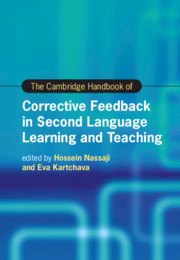Book contents
- The Cambridge Handbook of Corrective Feedback in Second Language Learning and Teaching
- Cambridge Handbooks in Language and Linguistics
- The Cambridge Handbook of Corrective Feedback in Second Language Learning and Teaching
- Copyright page
- Contents
- Figures
- Tables
- Contributors
- Acknowledgments
- Introduction Corrective Feedback in Second Language Teaching and Learning
- Part I Theoretical Perspectives on Corrective Feedback
- Part II Methodological Approaches in the Study of Corrective Feedback
- Part III Different Delivery Modes of Corrective Feedback
- Part IV Feedback Provider, Feedback Intensity, and Feedback Timing
- Part V Corrective Feedback and Language Skills
- 17 Corrective Feedback and the Development of Second Language Grammar
- 18 Corrective Feedback and the Development of Second Language Vocabulary
- 19 Effects of Corrective Feedback on Second Language Pronunciation Development
- 20 Corrective Feedback in Instructional Pragmatics
- 21 Alphabetic Print Literacy Level and Noticing Oral Corrective Feedback in SLA
- Part VI Contexts of Corrective Feedback and Their Effects
- Part VII Learners’ and Teachers’ Feedback Perspectives, Perceptions, and Preferences
- Part VIII Individual Differences, Tasks, and Other Language- and Learner-Related Factors
- Index
- References
17 - Corrective Feedback and the Development of Second Language Grammar
from Part V - Corrective Feedback and Language Skills
Published online by Cambridge University Press: 26 February 2021
- The Cambridge Handbook of Corrective Feedback in Second Language Learning and Teaching
- Cambridge Handbooks in Language and Linguistics
- The Cambridge Handbook of Corrective Feedback in Second Language Learning and Teaching
- Copyright page
- Contents
- Figures
- Tables
- Contributors
- Acknowledgments
- Introduction Corrective Feedback in Second Language Teaching and Learning
- Part I Theoretical Perspectives on Corrective Feedback
- Part II Methodological Approaches in the Study of Corrective Feedback
- Part III Different Delivery Modes of Corrective Feedback
- Part IV Feedback Provider, Feedback Intensity, and Feedback Timing
- Part V Corrective Feedback and Language Skills
- 17 Corrective Feedback and the Development of Second Language Grammar
- 18 Corrective Feedback and the Development of Second Language Vocabulary
- 19 Effects of Corrective Feedback on Second Language Pronunciation Development
- 20 Corrective Feedback in Instructional Pragmatics
- 21 Alphabetic Print Literacy Level and Noticing Oral Corrective Feedback in SLA
- Part VI Contexts of Corrective Feedback and Their Effects
- Part VII Learners’ and Teachers’ Feedback Perspectives, Perceptions, and Preferences
- Part VIII Individual Differences, Tasks, and Other Language- and Learner-Related Factors
- Index
- References
Summary
This chapter reviews themes in research into the effectiveness of oral corrective feedback, typically provided by language teachers, on L2 grammatical development. It synthesizes research evidence for the effects of oral corrective feedback on learners’ development of grammar and the relative efficacy of different corrective feedback strategies, such as output-prompting and input-providing. Further themes concern the effectiveness of oral corrective feedback on salient and non-salient grammatical features and in relation to learners’ varying levels of knowledge of the targeted features. Even though most research in this area concerns the development of accuracy, the chapter includes a review of the considerably smaller body of literature that offers insights into the potential value of oral corrective feedback on the development of fluency. The chapter reviews the different kinds of oral and written tests that have been used in research to gauge grammar learning, some of which teachers may wish to consider adopting to assess their learners. Based on the cumulative evidence from research, we make suggestions for classroom teachers, although we recognize that teachers’ decisions about the provision of oral corrective feedback are often based on multiple factors, including affective factors and teaching objectives.
Keywords
- Type
- Chapter
- Information
- The Cambridge Handbook of Corrective Feedback in Second Language Learning and Teaching , pp. 367 - 386Publisher: Cambridge University PressPrint publication year: 2021
References
- 2
- Cited by

